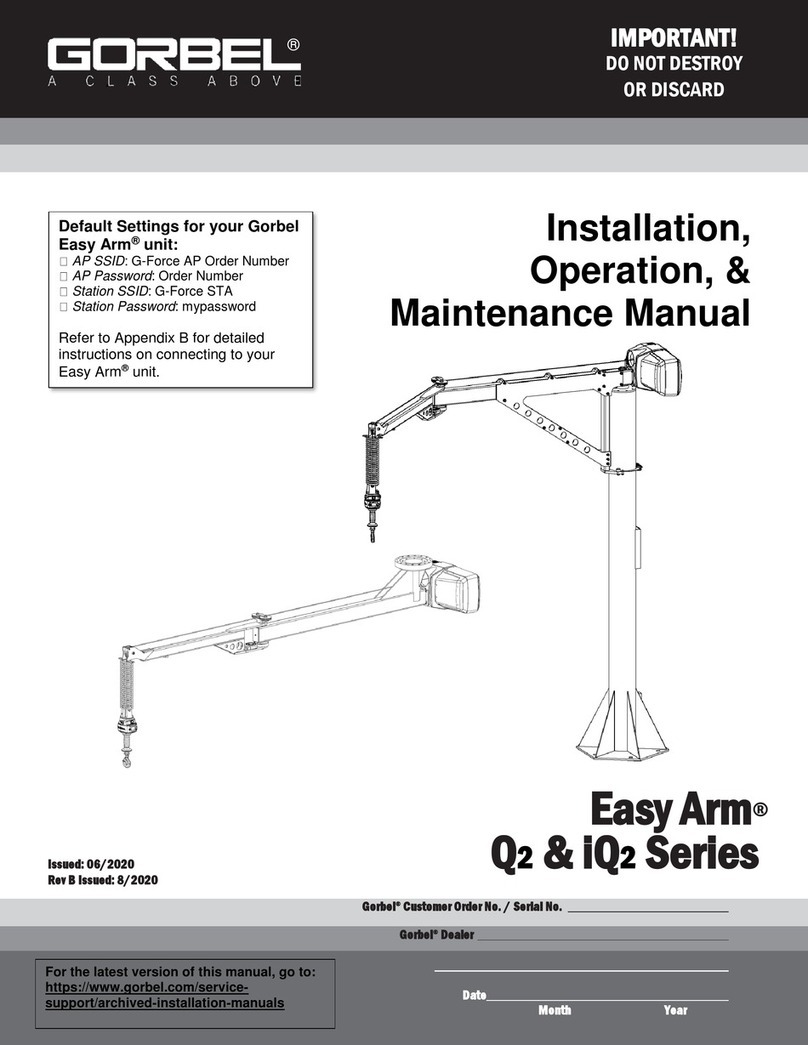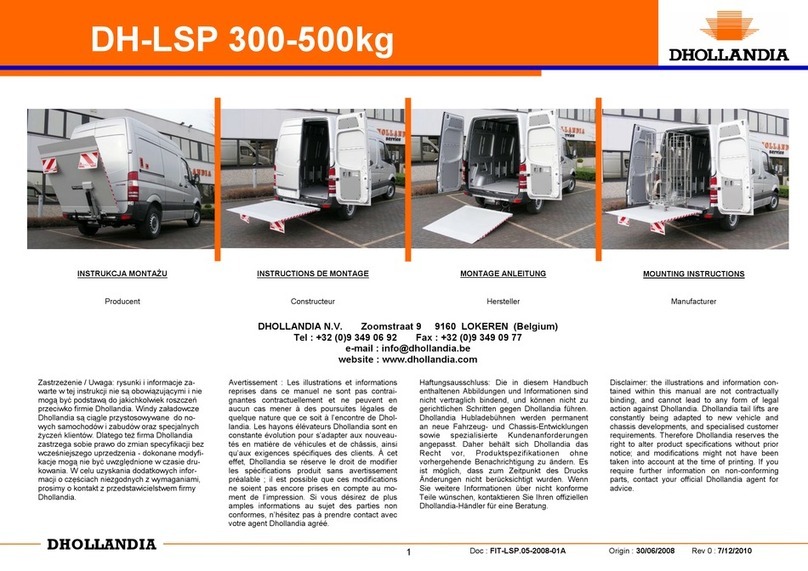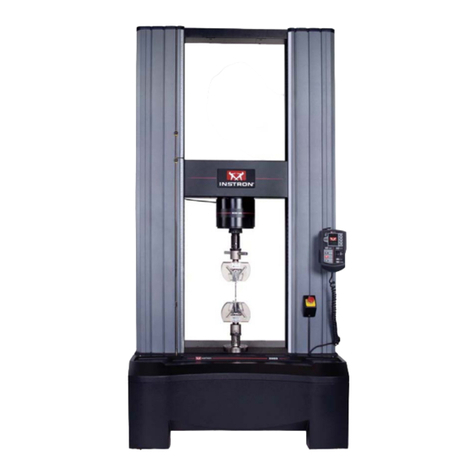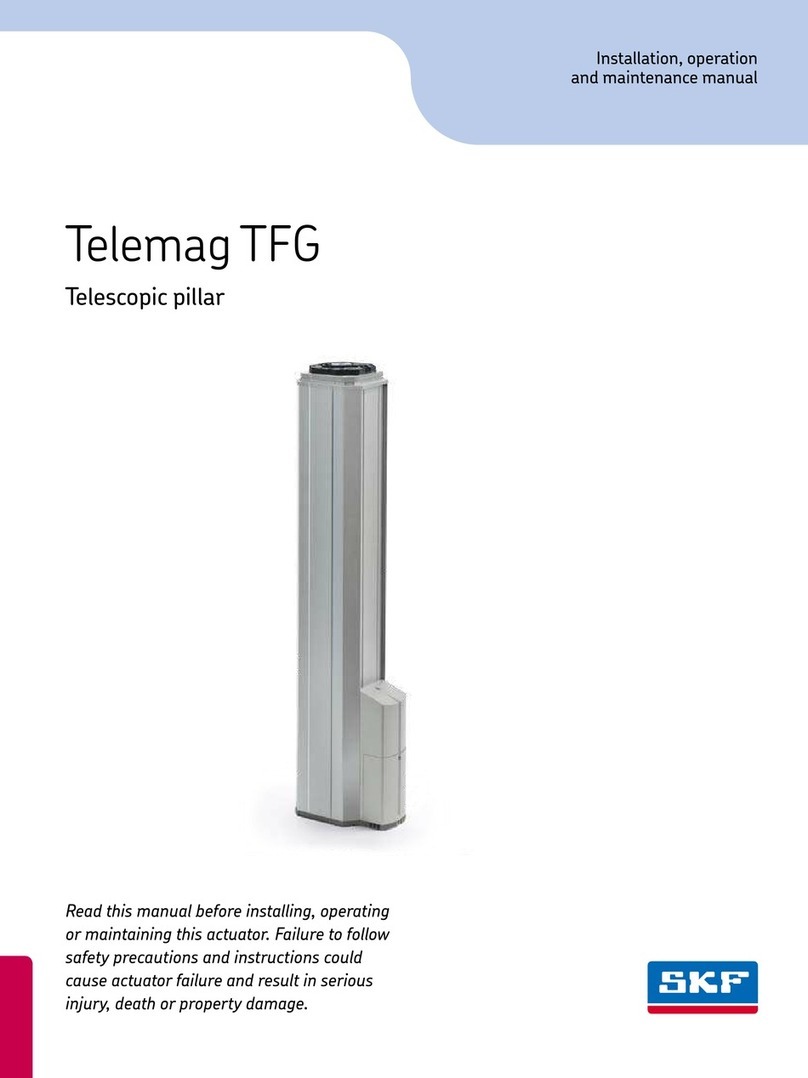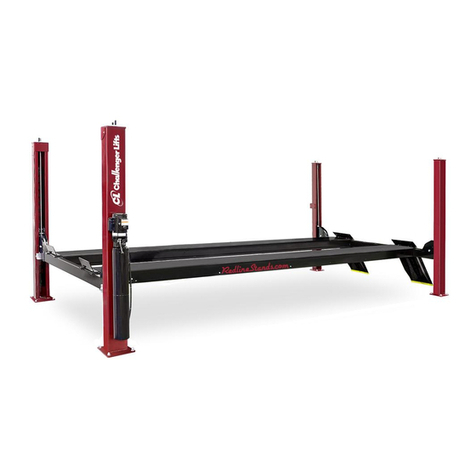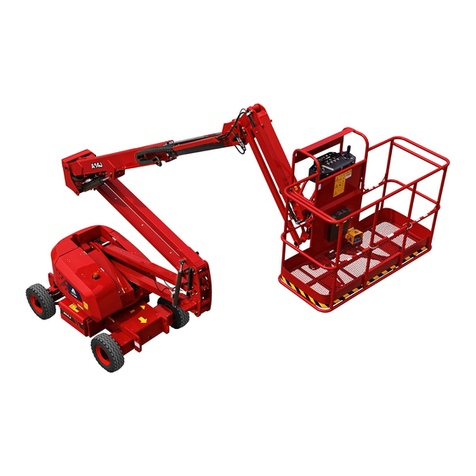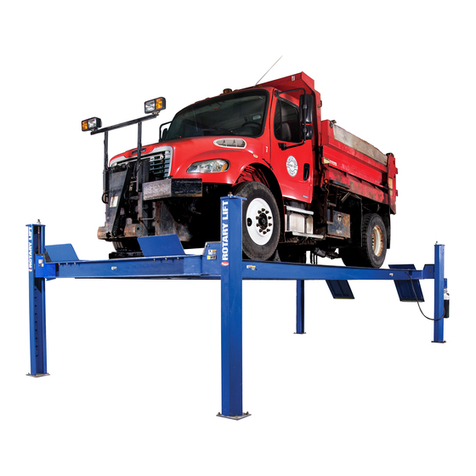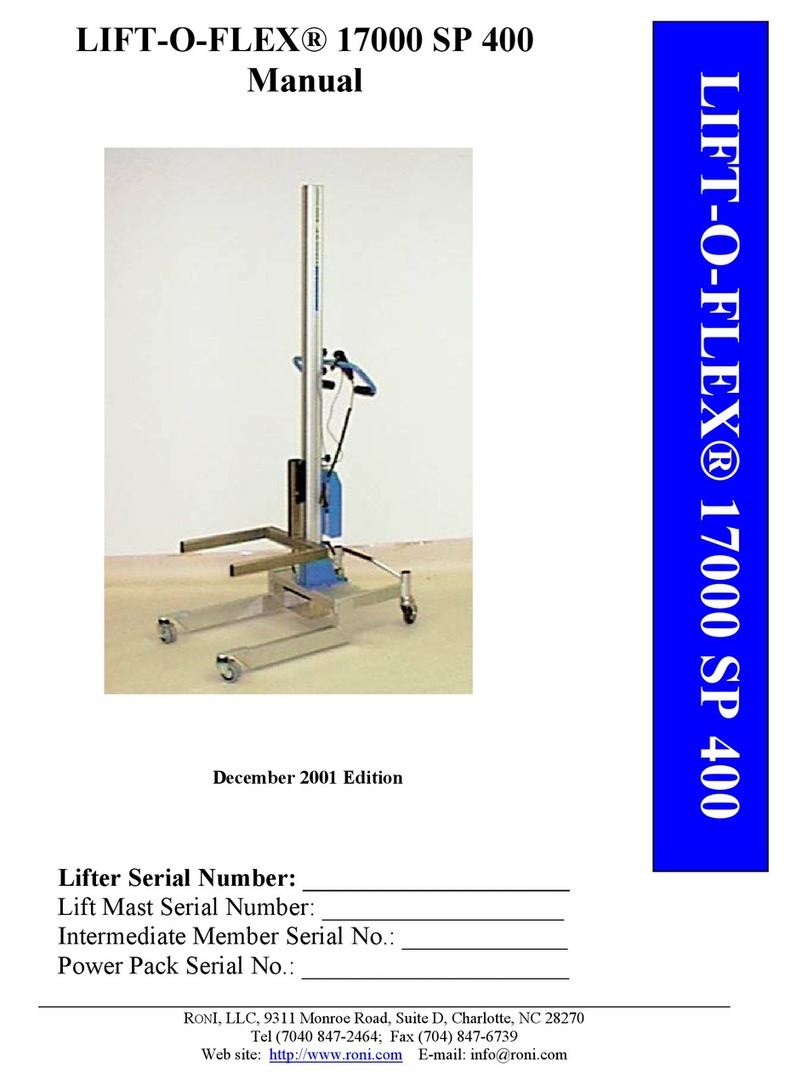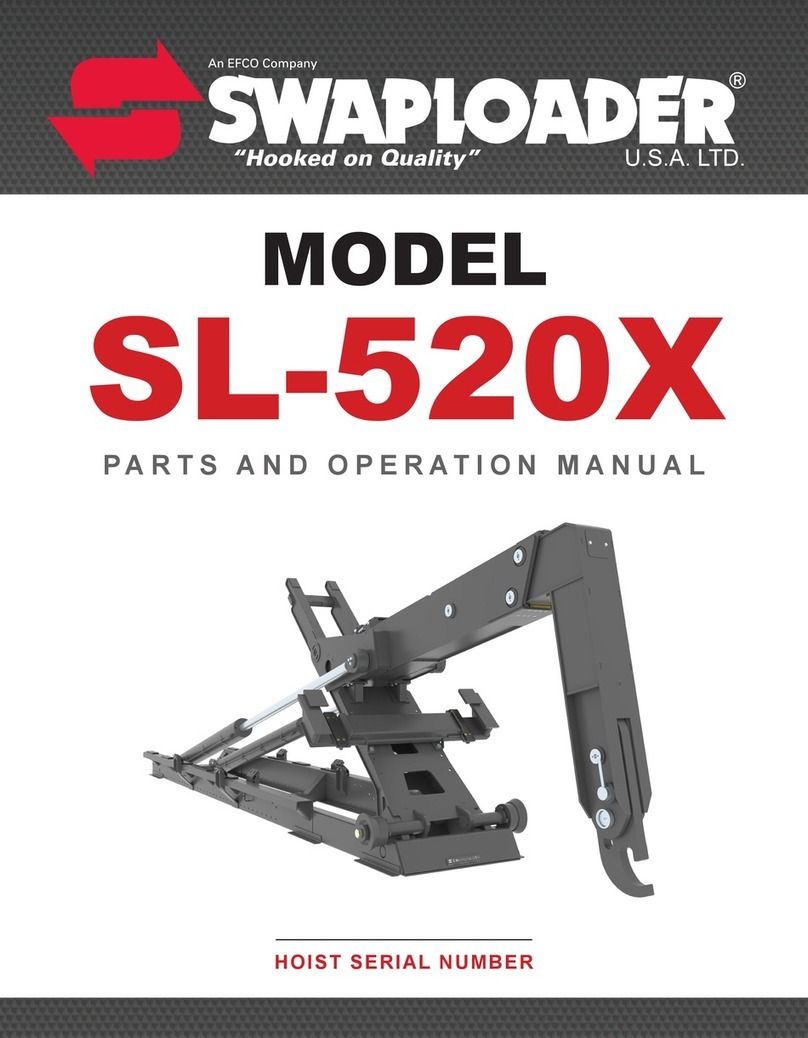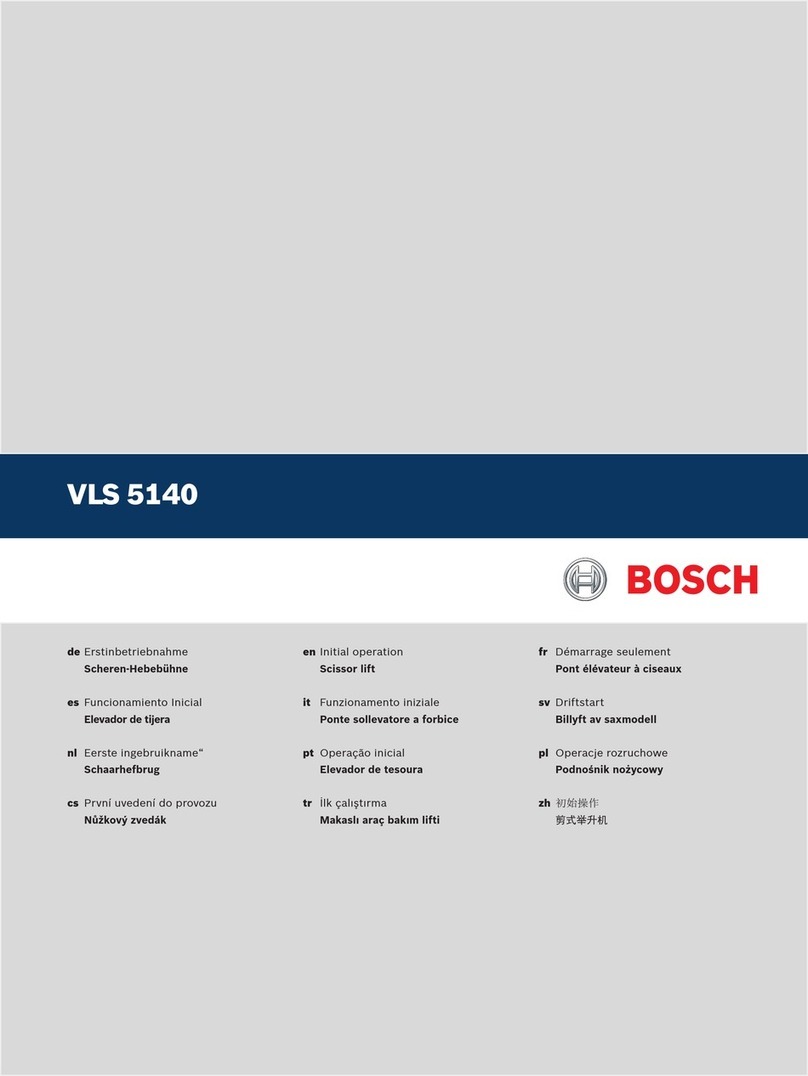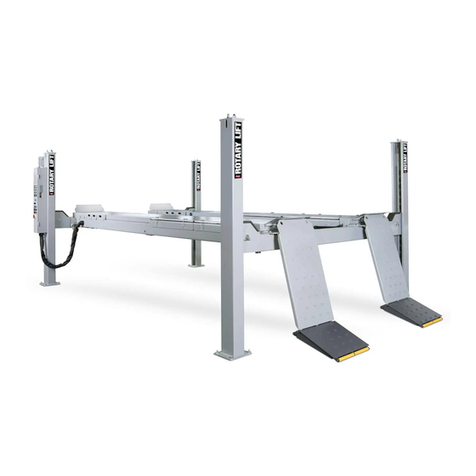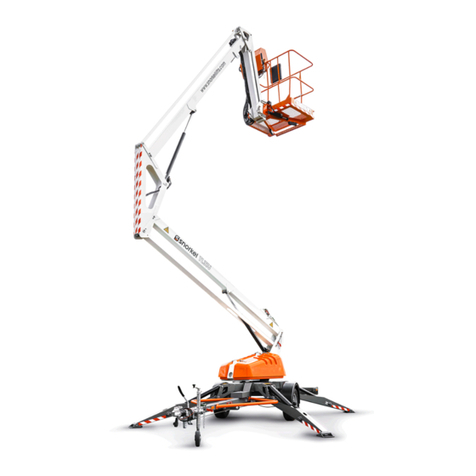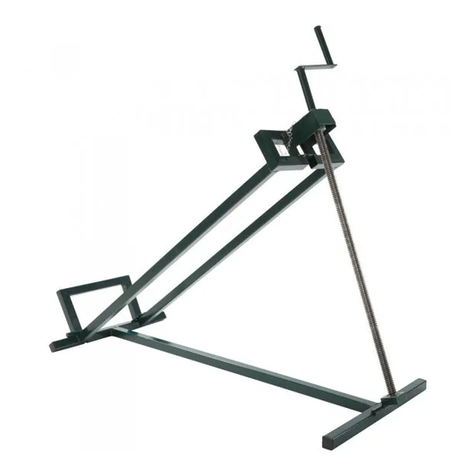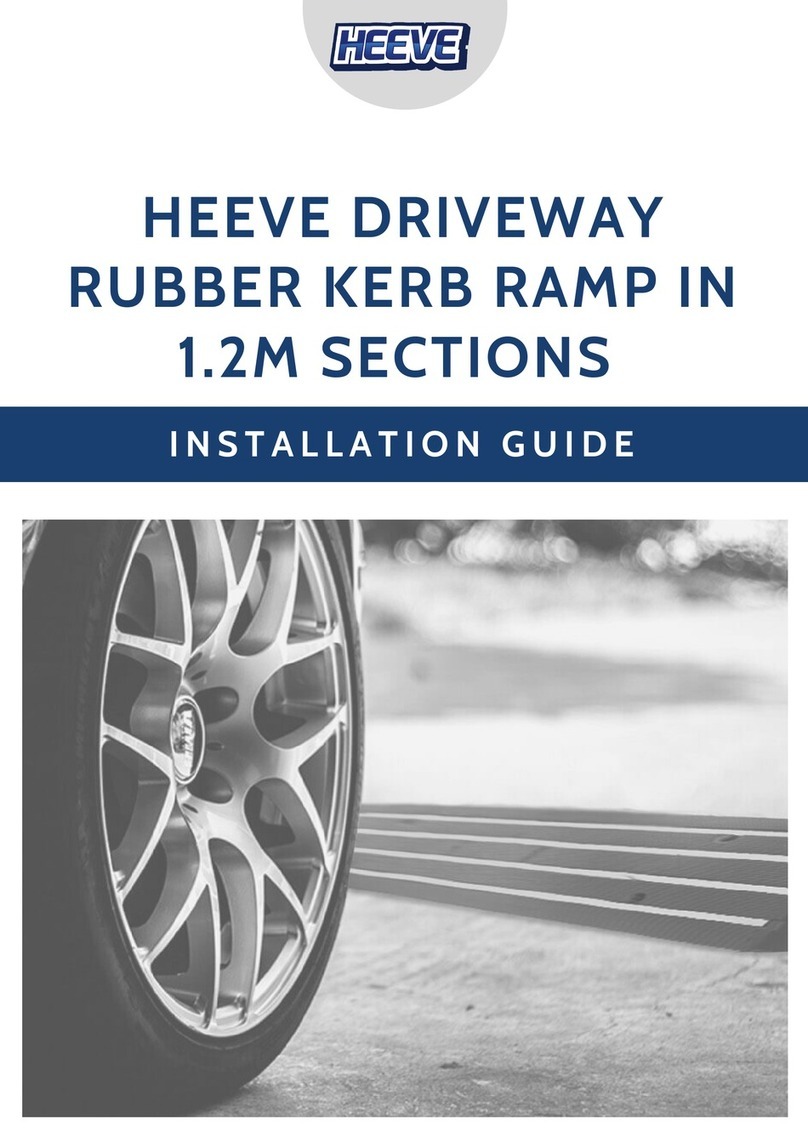GORBEL Ranger User manual

IMPORTANT!
DO NOT DESTROY
Operation, Use &
Maintenance Manual
Month Year
Gorbel®Dealer
Date
Gorbel®Customer Order No. / Serial No.
®

TABLE OF CONTENTS
Definition of Terms ....................................................................................... 1
Introduction................................................................................................... 2
Application.................................................................................................... 3
Minimum Platform Height for Safe Use........................................................ 4
Warnings and Restrictions ........................................................................ 5-6
Specifications ...........................................................................................7-11
Operation
Step 1 - Positioning ................................................................................................12
Step 2 - Height Adjustment ....................................................................................13
Step 3 - Raising and Locking .................................................................................14
Step 4 - Final Positioning .......................................................................................15
Step 5 - Leveling.....................................................................................................16
Step 6 - Final Steps................................................................................................16
Step 7 - Unlocking and Lowering ...........................................................................17
Step 8 - Stowing .....................................................................................................17
Step 9 - Battery Charging.......................................................................................18
Step 10 - Towing/Transporting ............................................................................19-20
Labels.....................................................................................................21-22
Authorized Person Instructions................................................................ 23
General Use Requirements....................................................................24-25
Limited Warranty ........................................................................................ 26
Inspection and Maintenance Schedule ..................................................27-34
Wiring Schematics..................................................................................35-36
Inspection and Maintenance Log ............................................................... 37
Authorized Person Signature Log............................................................ 38
Questions? Concerns? Comments? Please call (800) 821-0086 (US and Canada) or
(585) 924-6262 (outside US).

DEFINITION OF TERMS
AUTHORIZED PERSON - ANSI defines an Authorized Person as a “person assigned by the employer to perform
duties at a location where the person will be exposed to a fall hazard”.
ANTI-RATCHETING - This refers to a feature of an SRD that prevents a cascading effect during a fall event. When
a personnel fall arrest system has the capacity to act as a spring (e.g. cantilevers, flexible lifelines, fast braking
SRDs with web lines, stretch harnesses), the user may experience a zero G condition which could unlock an SRD
thus causing a smaller secondary fall. SRDs with this feature will remain locked during a spring-back event.
COMPLETE FALL ARREST SYSTEM - A Complete Fall Arrest System consists of three main components:
A. Engineered Anchor System - Gorbel’s Ranger and Road Ranger have been engineered to provide the
maximum safety possible. The mobile design allows for easy repositioning, ensuring that the anchor point
can be located directly over the work area.
B. Body Support - Only a full body harness is allowed for fall arrest systems. Proper fitting and wearing of the
harness is critical so that it can evenly dissipate the fall arrest forces to the strongest body parts.
C. Connecting Means - This is the link between the anchor and body support. A self-retracting device is
recommended. This provides maximum mobility and minimum fall distance. An energy absorbing lanyard
may also be used. These components must have an average arresting force of 1350 lbs. or less.
FALL CLEARANCE ZONE - The space below the person where there is a potential to fall. This space must remain
clear of obstructions to prevent injury from contact with any objects during a fall event.
LEADING EDGE - The edge of the working surface that a person could fall off. This edge may restrict the lifeline
from reaching a vertical orientation and cause off-vertical (horizontal) loading of the anchorage system. Avoid sharp
Leading Edges or use lifelines designed to withstand a sharp Leading Edge fall event.
QUALIFIED PERSON - ANSI defines a Qualified Person as “A person with a recognized degree or professional
certificate and with extensive knowledge, training and experience in the fall protection and rescue field who is
capable of designing, analyzing, evaluating and specifying fall protection and rescue systems...”
SRD - Self-Retracting Device
COMPETENT PERSON - In the context of fall protection, OSHA defines a Competent Person as a person who
is capable of identifying hazardous or dangerous conditions in the personal fall arrest system or any component
thereof, as well as in their application and use with related equipment.
1
12/16 Rev. A

INTRODUCTION
Congratulations on your purchase of a Ranger™ Mobile Fall Arrest Anchor. Comprehensive development and
testing has allowed you to procure a top-quality mobile anchor product to protect your employees from harm while
working at height. When properly applied, set-up, and used under supervision from a Qualified Person, Ranger™
Mobile Anchors provide a user-friendly solution for a variety of applications. The ability to position the anchor
directly above the fall hazard combined with an attached self-retracting device (SRD) minimizes fall distance while
the optimized flexible counterweight design reduces arrest force to the user. The Ranger’s reliable performance
along with an ANSI-approved Managed Fall Protection Program provides safety assurance to the user and aims to
encourage further safe work practices.
The Ranger’s innovative design minimizes the required counterweight, allowing mobility to optimally position the
anchor. The combination and strategic placement of outriggers and jacks reduces movement in the event of an
offset fall. When leveled on a non-deforming surface, no more than 12 inches is required for the deflection and
movement of the Ranger in the fall clearance calculation.
This manual describes the operation, use and maintenance of Gorbel’s Ranger™ Mobile Anchors. These products
currently consist of the Ranger and the Road Ranger. The Ranger is intended for indoor or tarmac use and can only
be used on slopes up to 2°. It has a hard mounted axle and must not be towed at speeds greater than 25 MPH. It’s
smaller footprint, lighter weight, folding tongue and integral dolly make it ideal for easy maneuvering on hard, flat
surfaces.
The Road Ranger provides the same safe and secure anchorage point as the Ranger with the added ability to be
used on slopes up to 5°. The Road Ranger comes equipped with electric brakes, required Federal lighting, parking
brake, torsion axle, safety towing chains, and safety towing break-away system. It meets all the requirements for a
specialty equipment trailer and can be licensed (if required by your state, county or province) for highway travel at a
maximum speed of 65 MPH.
Prior to shipment, all Ranger™ Mobile Anchors are statically proof loaded to verify compliance with the 2X OSHA
required safety factor for the worst case suspended load condition. During the verification phase, dynamic testing
was performed to ensure conformity with the most current ANSI guidelines. The dynamic safety factor of the Ranger
well exceeds OSHA requirements.
Please review the entire manual and have your employees sign the back cover as verification of understanding this
manual. All users must understand the safe requirements for the use of the Ranger and its compatible attachments.
Fall arrest is the last line in protection for workers at risk of a fall from height. Your adherence to all warnings
contained in this manual and in the instructions of all the components of the entire fall arrest system is required.
Please contact Gorbel for any clarification or questions you may have.
212/16 Rev. A

APPLICATION
The Ranger™ Mobile Anchors are the best choice for providing temporary coverage to a conical work zone where
it is not practical to install a permanent solution. A flat work area is a circle with the center directly under the anchor
having a diameter equal to the difference of the anchor height and the work surface height.
When the Ranger or Road Ranger is leveled and load is removed from the wheels, the bearing pressure of the
tongue jack is twice the bearing pressure of the outrigger feet. If inspection of the surface at the tongue jack reveals
sinking, there is not an adequate safety factor for the supporting surface bearing capacity.
The Ranger and Road Ranger have three height settings, 18’, 20’ and 22’. This setting is adjusted prior to the mast
being raised. If overhead clearance is adequate, it is recommended to keep the height at the factory setting of 22’.
This will provide the largest safe work area. The anchor must be sufficiently above the work surface so that the SRD
is above the user and its cable or webbing is always in tension. For example, the worker’s back harness D-ring is 5’
off the work surface and the SRD with carabiner is 20” long retracted, then the maximum work surface height, with
the Ranger set at 22’, would be 15’ above the supporting surface to always ensure the SRD’s cable or webbing is in
tension.
The minimum working height from the supporting surface is dependent on all components that comprise the fall
arrest system. See the next section for examples and requirements for SRD selection.
Indoor and outdoor use are possible. Ranger™ Mobile Anchors use sealed structural tubing, ultra-corrosion resistant
hardware, and a durable two part urethane coating to provide years of maintenance free use in a typical outdoor
environment. Contact Gorbel if your application involves an extreme corrosive environment.
DANGER
Ranger™ Mobile Anchors must never be supported within 2 feet of an edge or change in elevation.
WARNING
Ranger™ Mobile Anchors must be supported by a firm surface.
WARNING
Fall protection of Ranger™ Mobile Anchors is restricted to within a 30 degree from vertical cone about the anchor.
MAXIMUM
LOADING
ANGLE FROM
VERTICAL IS 30°
6'-0" MIN.
Figure A. Safe Working Zone
3
12/16 Rev. A

MINIMUM PLATFORM HEIGHT FOR SAFE USE
There are a variety of factors to consider when a Qualified Person is determining the minimum platform height for
use with a Ranger or Road Ranger. These factors include, but are not limited to, the following:
• SRD performance
• The SRD shall be an Anti-Ratcheting design due to the flexible nature of the anchorage
• If work conditions allow the SRD cable to contact the Leading Edge of the work surface, a SRD
rated for this application must be used (Leading Edge SRDs may have different clearance
requirements)
• Follow all manufacturer’s guidelines concerning the use and inspection of SRDs
• Anchor deflection
• The Ranger has a 12” maximum deflection when used on a firm and level surface
• Harness stretch
• Required safety margin
• Work position (standing, kneeling, laying down)
• Swing fall drop (offset distance height)
Example #1:
• ANSI Z359.14 Class A SRD, maximum
arrest distance = 24”
• Anchor deflection (max.) = 12”
• Harness stretch = 12”
• Required safety margin = 24”
• Standing work position
• Anchorage directly overhead (no swing
fall drop)
In this specific scenario, the minimum work
platform height would be:
24” + 12” + 12” + 24” = 72” (or 6’-0”)
Example #2:
• ANSI Z359.14 Class B SRD, maximum
arrest distance = 54”
• Anchor deflection (max.) = 12”
• Harness stretch = 12”
• Required safety margin = 24”
• Standing work position
• Anchorage directly overhead (no swing
fall drop)
In this specific scenario, the minimum work
platform height would be:
54” + 12” + 12” + 24” = 102” (or 8’-6”)
412/16 Rev. A

WARNINGS AND RESTRICTIONS
1. Do not throw away these instructions. Always keep a copy with equipment.
2. Read and understand this manual before operating and using equipment.
3. The information contained in this manual should be incorporated as part of a training program as required by
OSHA or any state and local regulatory agency.
4. This and any other included instructions shall be provided to the users of this equipment. The user shall
demonstrate understanding of the proper equipment use and limitations.
5. Any fall event can result in injuries. The proper use of this equipment can eliminate or substantially reduce
an injury. For maximum safety, the worker shall be trained in the proper use of this equipment and all of the
components of the Complete Fall Arrest System.
6. A managed fall protection program which includes a rescue plan is required for the safe use of this equipment.
A worker suspended from this system can lose vital blood flow to the brain as blood pools in the legs. This is
referred to as suspension trauma. Incorporating a rescue plan that can be enacted in less than 15 minutes is the
best method to reduce this risk.
7. The Ranger and Road Ranger are only to be used as part of a complete fall protection system. The buyer or
user is responsible for the safety and compatibility of the complete system. Nether Gorbel, nor its distributor,
takes responsibility for the system as a whole. The Ranger and Road Ranger are designed and tested by Gorbel
in accordance with applicable OSHA requirements and ANSI Z359 guidelines using a minimum design factor of
two. The structural steel construction is designed in accordance with applicable AISC guidelines.
8. The end user is responsible to make sure that the Complete Fall Arrest System and its application is
configured, operated and used under the supervision of a Qualified Person in accordance with application
OSHA regulations and ANSI Z359 Fall Protection Code voluntary consensus standard. State and local
jurisdictions may have additional requirements.
9. It is the responsibility of the user to determine the sustainability of equipment and any attachments prior to
each use and to have certification inspection on a periodic basis with recurrence of at least once per year by a
Qualified Person.
10. Any component replacement, addition or change to the complete system requires evaluation by a Qualified
Person.
11. Do not field modify the Ranger or Road Ranger in any way. Any modifications without the written consent of
Gorbel Inc. will void warranty.
12. Consult a Qualified Person to determine if your supporting surface is adequate to support the bearing pressure
generated by the equipment’s weight and the arresting force. Gorbel Inc. assumes no responsibility for the
adequacy or integrity of the supporting surface.
13. Before each use, the equipment shall be inspected as outlined in the inspection section of this manual.
14. Lanyards or Self Retracting Devices (SRDs) to be used with the Ranger and Road Ranger shall have an
Average Arresting Force (AAF) equal to or less than 1350 lbs.
15. The rated capacity and the rated maximum average arresting force of the Ranger shall not be exceeded. If
the lanyard or SRD connected to the Ranger does not list an Average Arresting Force, the Maximum Arresting
Force rating listed shall not exceed the Maximum Average Arresting Force of the Ranger or Road Ranger.
16. Customer chosen lanyards or SRDs shall minimize freefall distance.
17. It is the responsibility of the end user to verify that the height of the Ranger™ Mobile Anchors will provide
adequate fall clearance when used with the customer chosen lanyard or SRD and harness.
18. Ranger™ Mobile Anchors shall have no more than one person attached.
19. Ranger™ Mobile Anchors shall be optimally positioned to minimize a swing fall and the lengthening of the
freefall distance.
20. This equipment is not electrically insulated. Stay clear of power lines in accordance with federal and local
guidelines. Do not operate or use this equipment during a lightning storm. If equipment comes in contact with
electrically charged power lines, DO NOT touch or operate equipment until electricity has been removed from
the lines.
21. The Fall Clearance Zone shall be free of dangerous obstructions and electrical hazards.
22. To avoid the equipment from tipping over: never exceed the rated capacity, never raise the boom on greater
than a 2 degree slope for the Ranger or a 5 degree slope for the Road Ranger, only set-up on a firm surface,
never use unless equipment is leveled and all footpads are in firm contact with supporting surface.
23. Do not move equipment with a fork lift when boom is raised.
24. Manual positioning of this equipment should never be attempted on surfaces with a slope greater than 2
degrees. Use wheel chocks before detaching this equipment from tow vehicle.
5
12/16 Rev. A

WARNINGS AND RESTRICTIONS (CONTINUED)
25. Unhitch trailer from tow vehicle before leveling to prevent damage to the trailer tongue and/or the tow vehicle.
26. This equipment may pivot and move up to 12 inches away from set-up location. Stay at least two feet away from
drop-offs, holes, unstable surfaces, and other possible hazards.
27. Only use equipment with outriggers extended and captured by back stops.
28. Stay clear of boom, mast and link during actuation to prevent potential crushing or pinching if actuator should
malfunction.
29. Locking features only function when the boom is fully extended. Only use this equipment when automatic locking
pin is fully engaged.
30. To prevent inadvertent operation of the actuator from other remote microwave devices, remove key before
using.
31. When in use, cordon off the area around this equipment to protect personnel from injury if the equipment moves
during a fall event and to protect this equipment from being hit by other moving equipment.
32. Only connect yourself to this equipment when set-up is complete.
33. Do not unlock boom when anyone is attached. Actuator is not rated for rescue or as a personnel lift.
34. The user may not be attached to a Ranger™ Mobile Anchor during repositioning. The user must safely descend
from the work surface, detach, and then the Ranger may be moved.
35. Do not use this equipment in weather conditions that may affect the user and/or the stability of this equipment
including but not limited to, lightning, wind gusts greater than 28 miles an hour, heavy downpours, and
temperatures below 0 degrees or above 110 degrees Fahrenheit.
36. Do not exceed 25 MPH when towing the Ranger or 65 MPH when towing the Road Ranger. Tow only when in
the stored position. Keep tires properly inflated and in good condition, and keep lug nuts properly tightened. Do
not overload your tow vehicle.
37. Use only a 2” ball on the tow vehicle with the factory supplied receiver on this equipment.
38. Do not tow or use this equipment if any component is bent, worn or not properly functioning.
39. Do not tow this equipment if tow vehicle mounting bracket, hitch, or ball is damaged.
40. 2” ball must be fully seated in receiver and receiver latch closed and locked with supplied pin before towing this
equipment.
41. On Road Ranger, before towing this equipment, make sure trailer safety chains are properly connected
according to SAE J684 and lighting is hooked up and functioning properly.
42. Where required by state or local requirements, make sure brakes and break-away switch are functioning
properly and break-away battery is charged before towing the Road Ranger.
43. When charging the battery, only use a 3-wire grounded extension cord connected to a grounded AC circuit.
44. This equipment is not designed to be used as a crane.
45. Failure to follow these instructions can result in serious injury or death.
612/16 Rev. A

SPECIFICATIONS
Ranger™ Technical Specifications
Ranger™
Maximum Capacity 310 lbs. (user with tools)
Maximum Lanyard or SRD AAF Rating 1350 lbs.
Maximum Number of Users 1
Maximum Towing Speed 25 MPH
Total Weight 2,685 lbs.
Tongue Weight 658 lbs.
Ground Clearance 8 in.
Leveling Capability 5°
Wedge Latch Coupler Use Only 2” Ball
Charger 110V 60 Hz
Battery for Mast, Link and Boom (1) 12V 79 amp-hour, Deka 7T31
Battery for Break-Away System NA
Tire Size ST 175/80 D13 Load Range C
Maximum Tire Air Pressure 50 psi
Tire Lug 1/2” Nut Torque 90 ft.-lbs.
Axle 3/8” U-Bolt Torque 30 ft.-lbs.
Axle Mounting 5/8” Bolt NA
Wheel Hub Bearing Castle Nut Torque See procedure on page 29
Ball Hitch Coupler 5/8” Bolt Torque 100 ft.-lbs.
Folding Tongue Coupler 5/8” Pin Bolt Torque 50 ft.-lbs.
Anchor D-Ring and Cradle 1/2” Bolt Torque 70 ft.-lbs.
Bolt-On A-Frame Tongue Jack 3/8” Bolt Torque 20 ft.-lbs.
Bolt-On Jacks 3/8” Bolt Torque 25 ft.-lbs.
3/4” Pin Bolt Torque snug tight - 70 ft.-lbs.
7/8” Pin Bolt Torque snug tight - 100 ft.-lbs.
Actuator and Gas Spring Bolt Torque 15 ft.-lbs.
Wireless Remote Frequency 915 Hz
Wireless Remote Battery (1) 12V A23
Localized Pressure, Outrigger Foot 53 psi
Localized Pressure, Tongue Jack 100 psi
Parking Brake No
Electric Brakes NA
Trailer Lights and Brake Connector NA
Spare Tire No
Folding Tongue Yes
Operating and Use Temperature Range 0° to 110° Fahrenheit
7
12/16 Rev. A

SPECIFICATIONS (CONTINUED)
Ranger™ Dimensional Information
Figure A. Ranger™ Dimensional Information.
812/16 Rev. A
6’ - 9”
REACH
7’ -11”
REACH
8’ - 7”
REACH

SPECIFICATIONS (CONTINUED)
Road Ranger™ Technical Specifications
Road Ranger™
Maximum Capacity 310 lbs. (user with tools)
Maximum Lanyard or SRD AAF Rating 1350 lbs.
Maximum Number of Users 1
Maximum Towing Speed 65 MPH
Total Weight 3,120 lbs.
Tongue Weight 625 lbs.
Ground Clearance 10 in.
Leveling Capability 5°
Wedge Latch Coupler Use Only 2” Ball
Charger 110V 60 Hz
Battery for Mast, Link and Boom (1) 12V 79 amp-hour, Deka 7T31
Battery for Break-Away System (1) 12V 5 amp-hour
Tire Size ST 205/75 D14 Load Range C
Maximum Tire Air Pressure 50 psi
Tire Lug 1/2” Nut Torque 90 ft.-lbs.
Axle 3/8” U-Bolt Torque NA
Axle Mounting 5/8” Bolt 120-155 ft.-lbs.
Wheel Hub Bearing Castle Nut Torque See procedure on page 29
Ball Hitch Coupler 5/8” Bolt Torque 100 ft.-lbs.
Folding Tongue Coupler 5/8” Pin Bolt Torque NA
Anchor D-Ring and Cradle 1/2” Bolt Torque 70 ft.-lbs.
Bolt-On A-Frame Tongue Jack 3/8” Bolt Torque NA
Bolt-On Jacks 3/8” Bolt Torque 25 ft.-lbs.
3/4” Pin Bolt Torque snug tight - 70 ft.-lbs.
7/8” Pin Bolt Torque snug tight - 100 ft.-lbs.
Actuator and Gas Spring Bolt Torque 15 ft.-lbs.
Wireless Remote Frequency 915 Hz
Wireless Remote Battery (1) 12V A23
Localized Pressure, Outrigger Foot 25 psi
Localized Pressure, Tongue Jack 50 psi
Parking Brake Yes
Electric Brakes 10” x 2-1/4” Drum
Trailer Lights and Brake Connector 7 Way RV Blade Style
Spare Tire Optional
Folding Tongue No
Operating and Use Temperature Range 0° to 110° Fahrenheit
9
12/16 Rev. A

SPECIFICATIONS (CONTINUED)
Road Ranger™ Dimensional Information
Figure B. Road Ranger™ Dimensional Information.
10 12/16 Rev. A
6’ - 9”
REACH

SPECIFICATIONS (CONTINUED)
Major Components of Ranger and Road Ranger
11
12/16 Rev. A
BOOM
ANCHORAGE
CONNECTOR
MAST
MAST LINK
AUTO-ENGAGE
LOCKPIN
DROP LEG JACK
BACKSTOP
OUTRIGGER
FOOT PAD
HEIGHT ADJUSTMENT PIN
ACTUATOR
TOOL BOX
BOOM REST
TONGUE JACK
HINGE
DOLLY
DOLLY HANDLE
FORK POCKETS OUTRIGGER TURNBUCKLE
BALL HITCH
COUPLER
CRANK
Figure C. Major Component Names

OPERATION
STEP 1 - POSITIONING
1.1 Using the tow vehicle or fork truck, position the anchor end near the work area, leaving room for the
outriggers to be deployed. If the slope is too great to manually position, the tow vehicle should be used for
final positioning. Ranger™ Mobile Anchor products must be used on firm, level ground, away from ledges
and drops.
1.2 Block the wheels. For the Ranger’s integral jack/dolly, unpin the tow dolly handle from the tongue. For the
Road Ranger, apply the parking brake. Remove the pin from the wedge latch coupler, open the latch and
reinsert the pin in the open position.
1.3 On the Road Ranger, set the pin on the drop leg tongue jack to minimize cranking. Wind the tongue jack
crank handle clockwise to lower the foot to the ground and lift the coupler from the ball of the tow vehicle.
If vehicle’s 2” ball will not separate from coupler, move the tow vehicle slightly back. Disconnect the safety
chains, break-away switch cable and wiring harness from the tow vehicle.
1.4 Move the tow vehicle away from the Ranger™ Mobile Anchor and adjust the tongue jack to level the unit
from front to back.
1.5 Only on the Ranger, the tongue may be folded to reduce the Ranger’s “in use” length and facilitate the use
of the integral dolly while final positioning. Remove the hairpin cotter pin on the folding tongue coupler hitch
pin. Pull out the folding tongue hitch pin and swing outer tongue toward frame. Outer tongue can be secured
to frame by aligning dolly handle bracket with bracket on the side of the frame and inserting pin.
12 12/16 Rev. A
WARNING
Never use blocking material under jacks or outriggers.
CAUTION
The integral jack/dolly, only on the Ranger, will be damaged if the pin holding the handle for towing is not
removed before lowering the wheels/jack foot.

13
12/16 Rev. A
STEP 2 - HEIGHT ADJUSTMENT (OPTIONAL)
2.1 In order to maximize work area, we recommend that
the 22’ position is used. In instances where overhead
obstructions prevent the use of the 22’ position, the
anchor height can be set to 20 or 18 feet high by
repositioning the link end pivot position with the
corresponding pivot holes on the frame using the link
hitch pin and link support strap.
2.2 The height adjustment must be performed with the
boom in the transport position. That is, the boom must
be fully supported by the boom rest (cradle) at one
end and the frame at the other end. Rotate the link
hitch pin to verify it is unloaded but DO NOT remove it.
If it will not rotate, jog the actuator slightly to release
any tension on the link (see Step 3). If the red lock out
key is installed, remove it to prevent accidental raising
of the boom during adjustment.
2.3 Attach the link support strap to the hooks welded
on either side of the mast and tighten so that the
link is supported by the strap.
2.4 Remove the lynch pin (locking ring pin) from the hitch pin and pull the pin handle to remove it from the
frame.
2.5 Using the link support strap, loosen or tighten the strap to align the lower link pivot bushings with the holes
in the frame corresponding to the desired height.
2.6 Reinsert the link hitch pin through the frame and link pivot end, and secure it with the tethered lynch pin
(locking ring pin) to complete the adjustment. Remove and store support strap.
Diagram 2A. Height adjustment.

STEP 3 - RAISING AND LOCKING
After Steps 1 & 2 have been completed, it is now safe to attach the SRD
and raise the mast. If the Ranger or Road Ranger is more than 2°out of
level, go to Step 5 to level the unit before raising the Mast.
3.1 Remove the pin from the rear drop leg jack, lower the foot to
the lowest overlapping hole, and reinsert the pin. Crank the
handle to lower the foot to within 1” of the ground.
3.2 Attach the SRD to the D-ring anchorage connector per the
instructions supplied with the SRD. Connect a tagline to the
SRD in order to access the SRD from ground level.
3.3 Unlock and flip back the three boom hold-down latches: (2) at
the boom rest and (1) at the rear of the frame; ensuring that
the latch claw is clear of the catch plate.
3.4 Insert the red lock out key into the slot located at the right rear
corner of the tool box. Turn the key 90 degrees clockwise to
power on the system.
3.5 Access the tethered pendant located inside the toolbox and
stand clear of the boom.
3.6 Press and hold the UP button to raise the unit, while standing at
a distance to the side of the unit to best view the boom as it
raises and check for obstructions in its path.
3.7 Continue to hold the UP button until the actuator reaches its
preset limit switch and stops. Check that the auto-engage lock pin
has fired and is fully seated.
3.8 Verify the coupling is in-line with the crank mounting bolt. When
the hinged connection between the coupling and crank is in-line
or just past in-line, the mast is locked. This hinged connection
should be within 1/4” of the frame backstop. If it is more, see the
Maintenance Section to adjust actuator limit switches. The
auto-engage lock pin and this in-line hinge provide the Ranger
and Road Ranger with double locking required for this kind of
equipment.
Diagram 3B. Mast Lock Pin Warning.
Diagram 3A. Pendant (left) and Wireless
remote (right).
WARNING
Never stand under the mast while it is being raised or lowered.
14 12/16 Rev. A
Diagram 3C. Mast Double Locking.

15
12/16 Rev. A
STEP 4 - FINAL POSITIONING
The Ranger can be positioned on firm, level ground using the built in tongue jack / trailer dolly. For the Ranger,
follow Steps 4.1 through 4.4.
4.1 Remove the hitch pin from the folding tongue and swing the tongue back against the side of the frame.
4.2 Extend the telescoping dolly handle to one of the preset positions and check that both of the spring buttons
are fully seated.
4.3 Pull up on the handle to engage the wheels and maneuver the Ranger into its final position.
NOTICE: Raising or lowering the handle angle beyond the dolly mechanism rolling range will engage the
foot and can act as an emergency brake.
4.4 Gently lower the handle to the ground to reengage the tongue jack foot and pivot the handle beneath the
unit to keep it out of the way.
The Road Ranger can be positioned on firm, level ground using the wheeled tongue jack. For the Road Ranger,
follow Steps 4.5 through 4.10.
4.5 Engage the parking brake. The parking brake is engaged when the handle is in-line with the tongue.
4.6 Pull the spring loaded pin on the wheeled jack and swing the jack wheels downward until the pin engages in
the position lock hole. The jack should be perpendicular with the tongue.
4.7 Align the wheels for the direction the Road Ranger will be pushed and lower the wheels using the wheeled
jack and/or raising the foot on the tongue leveling jack.
4.8 Release the parking brake (handle will be perpendicular to tongue) being careful to re-engage the brake if
the Road Ranger starts to roll on its own.
4.9 Push the Road Ranger into its final position optimizing the safe work area and minimizing the possible fall
distance.
4.10 Re-engage the parking brake and lower the leveling jack foot until it is in contact with the ground.

STEP 5 - LEVELING
5.1 Check the bubble level,
located in front of the
actuator, to determine the
high side of the Ranger™
Mobile Anchor.
5.2 Starting on the high side,
unpin and swing the
outrigger over the wheel to
the back stop plate.
5.3 Using the ratcheting
outrigger turnbuckle, lower
the outrigger until the foot
pad firmly contacts the
ground, making certain
that the backstop plate is
captured between the
outrigger and the outrigger
angle.
5.4 Switch to the low side and
repeat steps 5.2 and 5.3
and lower the outrigger until the Ranger™ Mobile Anchor is level from side to side.
5.5 Raise or lower the tongue jack to level the Ranger from front to back.
5.6 At this point both tires should be raised off the ground with the unit fully supported by the outriggers and
tongue jack. If the tires are contacting the ground, raise the outriggers and tongue jack until the unit is level
and the wheels are off the ground. If the feet sink into the ground and the wheels cannot be raised,
DO NOT USE. The ground is too soft.
5.7 Lower the rear drop leg jack until the foot just touches the ground.
STEP 6 - FINAL STEPS
6.1 With the unit raised, locked out and leveled, it is now safe to use the Ranger™ Mobile Anchor.
6.2 Turn the red lockout key counterclockwise and remove it to prevent accidental lowering of the mast while a
worker is attached.
6.3 Use the tagline to lower the SRD and hook it to the full body harness’s dorsal D-ring per the SRD
instructions.
DETAIL A
SCALE 1 : 2
BACKSTOP
OUTRIGGER
ANGLE
OUTRIGGER
Diagram 5A. Outrigger overlap.
16 12/16 Rev. A

STEP 7 - UNLOCKING AND LOWERING
After the worker has safely returned from height and detached the SRD from their dorsal harness D-ring, it is safe to
unlock and lower the boom.
7.1 Reinsert the red lockout key into the slot located at the right rear corner of the toolbox. Turn the key 90
degrees clockwise to power on the system.
7.2 Rotate the handle of the auto-engage lock pin clockwise to ensure the pin is unloaded. If you are unable
to rotate the handle, STOP! THE PIN IS LOADED AND SHOULD NOT BE REMOVED. Use the up arrow on
the remote to ensure the actuator is fully raised and recheck the pin handle.
7.3 If the pin is free, pull the handle to full extension with one hand, then depress the DOWN button on the
remote with the other hand. You can release the handle when you see the mast begin to lower.
7.4 Hold the DOWN button to continue lowering the mast, while standing clear of the path of the boom and
checking for obstructions.
7.5 Continue to hold the DOWN button until the boom is fully seated and resting on the boom rests, and the
actuator reaches its lower limit switch.
7.6 The actuator should have a minimum tension load to prevent it from rattling during travel.
7.7 Engage the three boom hold down latches: (2) at the boom rest and (1) at the rear of the frame; ensuring
that the latches are fully seated with their safety catches engaged.
7.8 Remove the red lockout key and store it with the manual.
NOTICE: The electric actuator is equipped with a manual override
option, in the event that power is lost and the actuator cannot be
lowered using the controls. To use the manual override:
1. Use a 3/16” hex wrench to remove the cap from the override
access port, located on the fixed end of the actuator.
2. While standing next to the actuator, use a cordless drill or
non-impact driver with a 1/4” square drive extension inserted
fully into the port. On slow speed, drive the actuator ball
screw counterclockwise to lower the unit while another
operator temporarily retracts and holds the auto-engage
spring pin handle to initiate the mast lowering procedure.
STEP 8 - STOWING
8.1 Detach the SRD from the D-ring and store it in the toolbox.
8.2 Secure the toolbox using a lock with up to a 3/8” diameter shackle.
8.3 Block the wheels to prevent the unit from rolling if parked on a slope or in the event of high winds.
8.4 Raise the rear drop leg jack to its highest setting.
8.5 Raise, fold away and pin the outriggers in their stowed position along the sides of the toolbox, ensuring that
the hitch pins are through the retaining eyelet on the outrigger as well as both holes in the frame mounted
bracket.
8.6 Install lynch pins (locking ring pins) into the outrigger retaining hitch pins.
8.7 Tension each outrigger ratchet turnbuckle to lower the outriggers and lightly preload the retaining hitch pins.
This will prevent the outriggers from rattling while towing.
8.8 For the Road Ranger, engage the parking brake (handle in-line with tongue).
17
12/16 Rev. A
Diagram 7A. Override access port.

STEP 9 - BATTERY CHARGING
This equipment is conveniently fitted with a 10 amp battery charger
and male 110V socket on the back of the toolbox for charging. It can
be charged with or without the lockout key in the socket. The charging
status light can be viewed on top of the charger, inside the toolbox. For
maximum battery life, we recommend the unit is charged weekly or every
30 up/down cycles, whichever comes first.
• DO NOT over discharge battery. Over discharge will lead to
battery failure.
• DO NOT charge battery in excessively hot temperatures; wait
until the cool of the evening.
• DO NOT charge near fuels, grain, dust, solvents or other flammables - charger can ignite flammable
materials and vapors.
• DO NOT charge battery if it may be frozen. See Battery section in Inspection and Maintenance Schedule for
more details.
9.1 Pull back the protective rubber cap from the charge port and plug in the female end of a 3-prong grounded
extension cord of 18 AWG or thicker. For safety, the extension cord length should be kept as short as practical
and located where it will not be stepped on, tripped over or otherwise subjected to damage or stress. The
charger must be plugged into a grounded and fuse-protected outlet of 2A or greater. Open the toolbox cover to
observe the charging status light on the charger. The charger will initially flash red for a few seconds, then turn
steady red. When the cycle is 80% complete, it will turn yellow, and finally green when the cycle is complete.
9.2 The charger can be plugged in overnight without fear of overcharging the battery. The charger is set to
maintain a full charge when plugged in.
9.3
When the battery is done charging, unplug and put away the extension cord, and reinstall the protective rubber
charge port cap.
18 12/16 Rev. A
Diagram 9A. Charging port.
Table of contents
Other GORBEL Lifting System manuals

